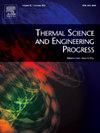黏滞耗散影响下的微极流体中超向波驱动的弯曲加热通道纤毛壁上的热量和质量输运
IF 5.1
3区 工程技术
Q2 ENERGY & FUELS
引用次数: 0
摘要
本研究研究了在超向波诱导运动驱动下,被限制在具有纤毛壁的弯曲加热通道内的微极流体的热量和质量输运特性。本研究的重点是研究粘性耗散如何影响由纤毛驱动的导电微极流体在具有类似于超向波的几何形状的弯曲通道中的输运。波形的设计是为了保持沿两面墙温度和浓度的一致分布。控制方程考虑了粘性耗散效应以及在热输运和溶质输运过程中起关键作用的Soret和Dufour效应。同时考虑了布林克曼数、磁场和耦合数的影响。润滑近似是问题表述的基础,然后用切比雪夫配置方案进行数值求解。结果表明:轴向速度随微极参数、曲率参数和磁场强度的增大而减小;然而,耦合数对轴向速度的显著提高有显著的贡献。这些结果为生物和工业系统提供了重要的见解,在这些系统中,小规模流体流动和能量损失起着关键作用,例如纤毛驱动的运输,芯片上的实验室设备和冷却系统。本文章由计算机程序翻译,如有差异,请以英文原文为准。
Heat and mass transport on ciliated walls of a curved heated channel driven by metachronal waves in micropolar fluids under the influence of viscous dissipation
This study investigates the heat and mass transport characteristics in micropolar fluids confined within a curved heated channel with ciliated walls, driven by metachronal wave-induced motion. This study focuses on examining how viscous dissipation influences the transport of an electroconductive micropolar fluid driven by cilia in a curved channel with a geometry shaped like a metachronal wave. The wave patterns are designed to maintain a consistent distribution of temperature and concentration along both walls. Governing equations account for the effects of viscous dissipation along with Soret and Dufour effects which play key roles in thermal and solutal transport processes. The influences of Brinkman number, magnetic field, and coupling number are also considered. The lubrication approximation forms the basis for problem formulation which is then numerically solved with the Chebyshev collocation scheme. The findings indicated that the axial velocity diminishes as the micropolar parameter, curvature parameter, and magnetic field strength increase. However, the coupling number notably contributes to a significant rise in axial velocity. The results provide important insights for biological and industrial systems where small-scale fluid flow and energy loss play a key role, such as in cilia-driven transport, lab-on-chip devices, and cooling systems.
求助全文
通过发布文献求助,成功后即可免费获取论文全文。
去求助
来源期刊

Thermal Science and Engineering Progress
Chemical Engineering-Fluid Flow and Transfer Processes
CiteScore
7.20
自引率
10.40%
发文量
327
审稿时长
41 days
期刊介绍:
Thermal Science and Engineering Progress (TSEP) publishes original, high-quality research articles that span activities ranging from fundamental scientific research and discussion of the more controversial thermodynamic theories, to developments in thermal engineering that are in many instances examples of the way scientists and engineers are addressing the challenges facing a growing population – smart cities and global warming – maximising thermodynamic efficiencies and minimising all heat losses. It is intended that these will be of current relevance and interest to industry, academia and other practitioners. It is evident that many specialised journals in thermal and, to some extent, in fluid disciplines tend to focus on topics that can be classified as fundamental in nature, or are ‘applied’ and near-market. Thermal Science and Engineering Progress will bridge the gap between these two areas, allowing authors to make an easy choice, should they or a journal editor feel that their papers are ‘out of scope’ when considering other journals. The range of topics covered by Thermal Science and Engineering Progress addresses the rapid rate of development being made in thermal transfer processes as they affect traditional fields, and important growth in the topical research areas of aerospace, thermal biological and medical systems, electronics and nano-technologies, renewable energy systems, food production (including agriculture), and the need to minimise man-made thermal impacts on climate change. Review articles on appropriate topics for TSEP are encouraged, although until TSEP is fully established, these will be limited in number. Before submitting such articles, please contact one of the Editors, or a member of the Editorial Advisory Board with an outline of your proposal and your expertise in the area of your review.
 求助内容:
求助内容: 应助结果提醒方式:
应助结果提醒方式:


